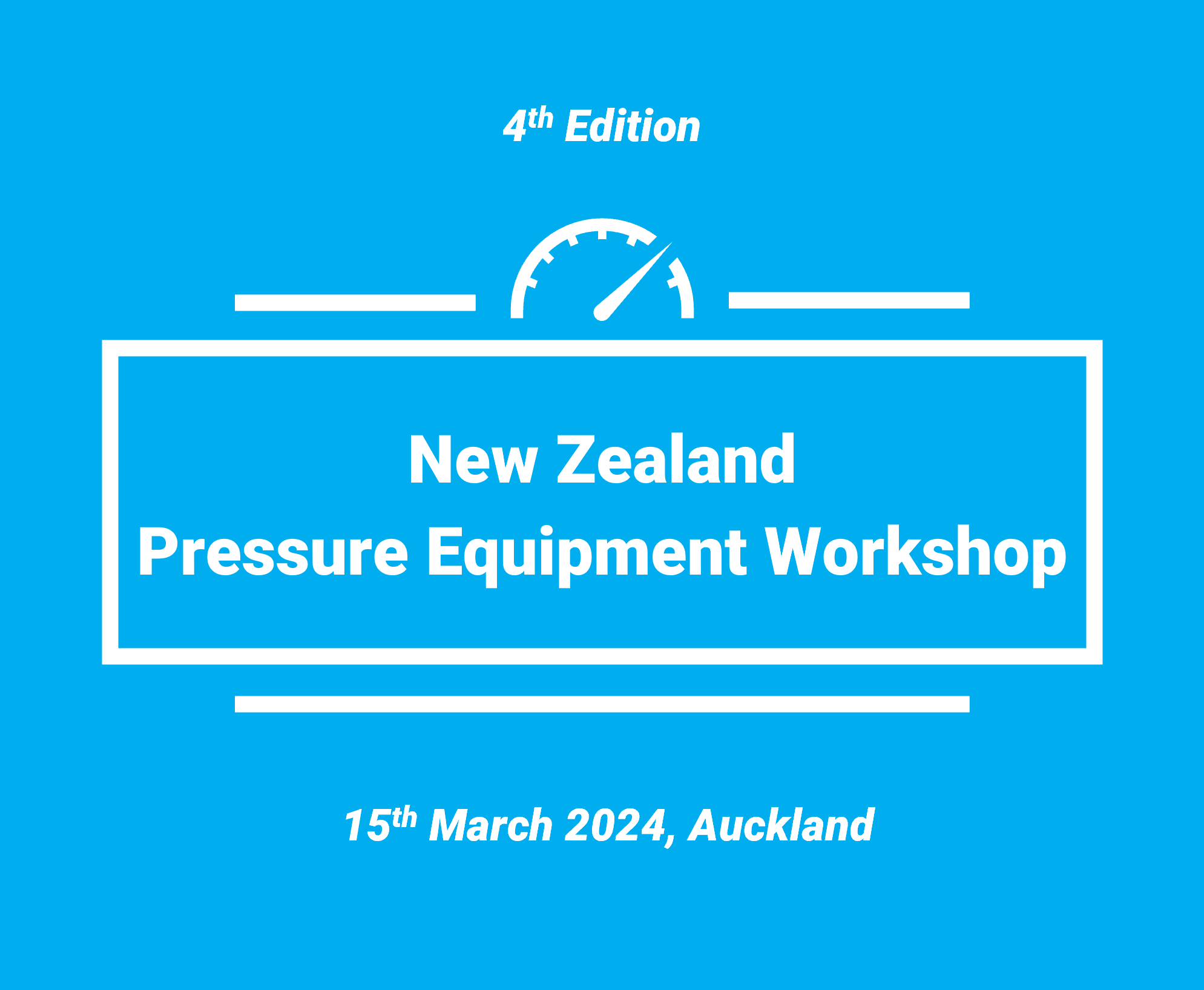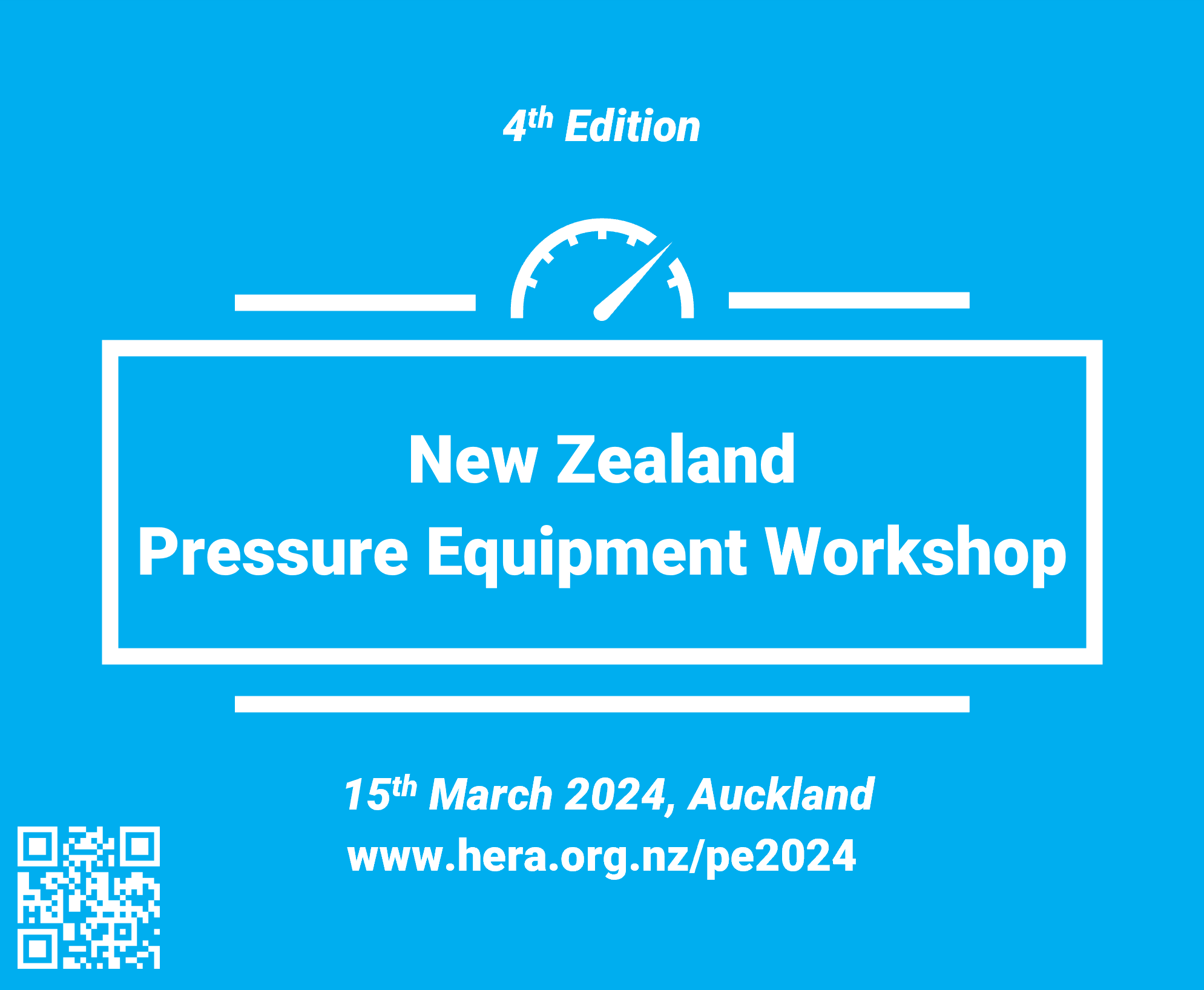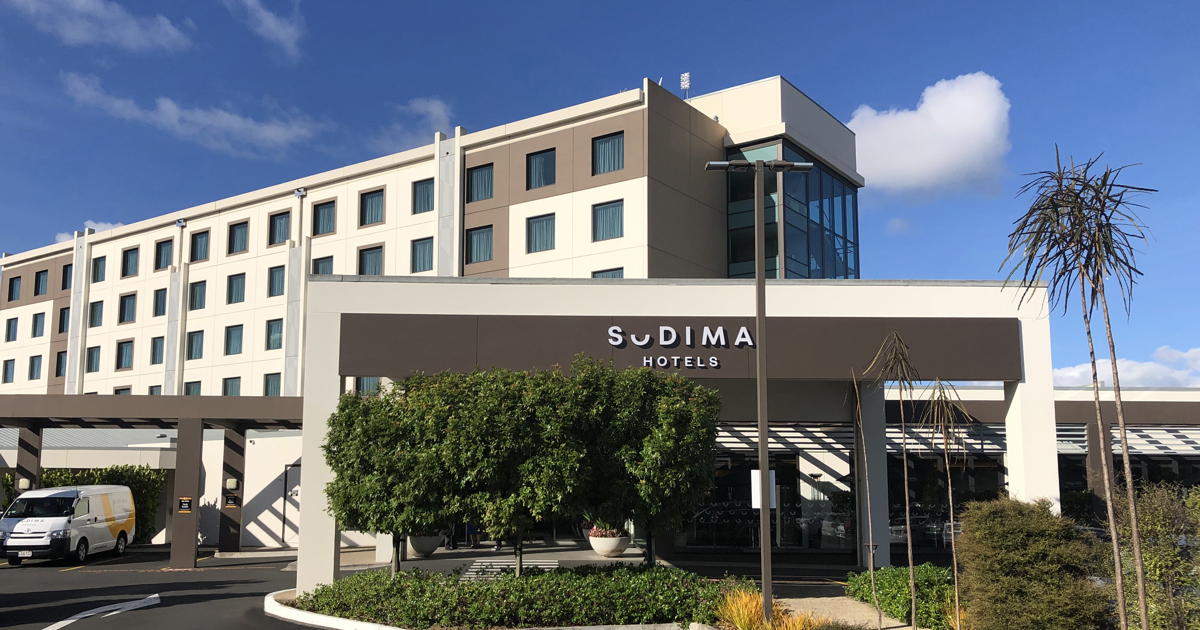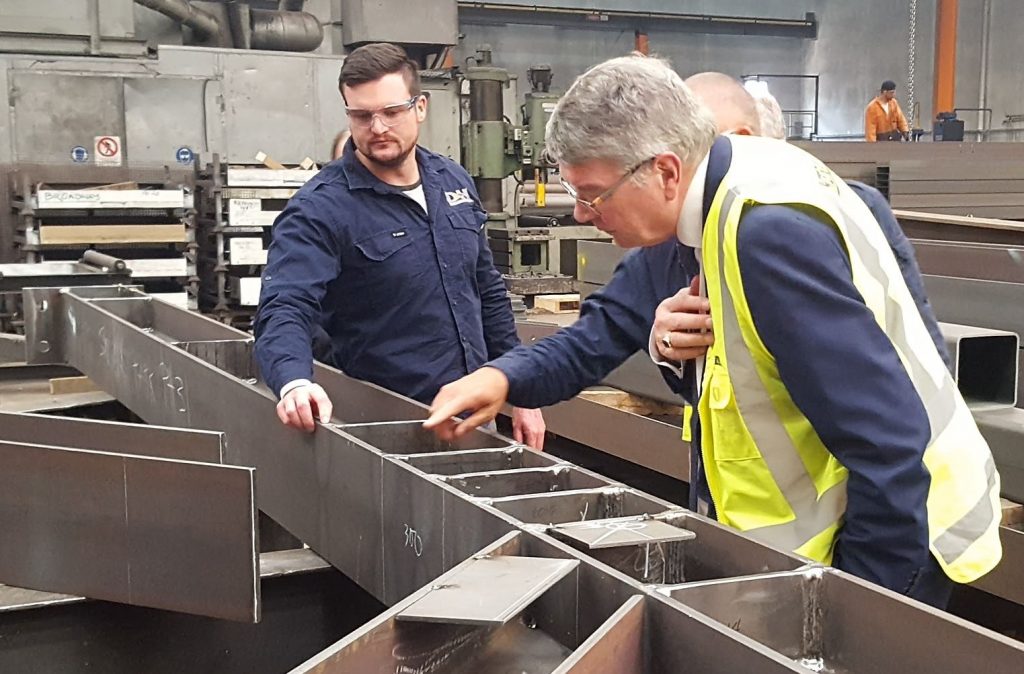
- This event has passed.
Pressure Equipment Workshop 2024
March 15

Pressure Equipment Workshop 2024 | 15 March 2024 | Auckland
Please join the conference group on LinkedIn to receive updates and help us spread the word.
LinkedIn group: Pressure Equipment Industry Workshop 2024
In March 2024, join HERA and the Pressure Equipment committee in Auckland for the 4th New Zealand Pressure Equipment Conference.
A day packed with speeches by internal presenters, two streams of local presenters, an update by the regulator and a panel discussion.
The Pressure Equipment Conference 2024 promises to be the outstanding technical forum for participants to further their knowledge-base by being exposed to diverse topics, and exchange opinions and ideas in a variety of topics related to Pressure Equipment industry. The conference is a great place to exchange ideas and to meet colleagues as we all work to create and advance Pressure Equipment technologies for our global community of practice. The Pressure Equipment Conference is a recognized forum for fruitful exchange of ideas.
The conference is run as a “by NZ industry for NZ industry” event and will cover a wide range of topics concerning the industry.

Who should attend?
The workshop will benefit designers, fabricators, inspectors, vendors, regulators, owners and operators.
The goals for the workshop are:
Sharing of technical information, innovation and practical experiences
Provide guidance and feedback; for the application and improvement of codes and regulations
Promote New Zealand’s capabilities
Promote consistency and best practice in the industry
Keynote presentations
ASME standards – Where we are at, how we got here and where we are heading
Christopher Cantrell – ASME, Senior Managing Director Overseeing Standards and Conformity Assessment
Abstract
In his keynote, Christopher Cantrell will discuss the history and evolution of the ASME standards. He will go over some key events and factors that have driven the development of these standards over the years. The presentation will provide insights into the current state of ASME standards and where the organization sees them heading in the future. Attendees can expect to gain a better understanding of the ASME standards and the role ASME sees itself in.
Presenter Profile: Christopher Cantrell
Christopher Cantrell, the Senior Managing Director at the American Society of Mechanical Engineers (ASME), is a seasoned professional with extensive experience in the field of mechanical engineering and safety standards. His role involves overseeing standards development and conformity assessment, ensuring compliance with industry norms and safety protocols.
Before joining ASME, Cantrell served as the chief boiler inspector for the state of Nebraska for 15 years. His expertise extends beyond regulatory roles; he actively participated in the field, serving as an inspector for Hartford Steam Boiler, the largest authorized inspection agency. Additionally, he volunteered on ASME committees, contributing to the advancement of engineering practices.
Pressure Piping B31
Glynn Woods / Tony Paulin
Abstract
This keynote presentation will cover the latest updates to B31J, B31H, and B31E task groups, and provide invaluable insights into pressure vessel and pipeline design, fitness-for-service assessments, and more. B31H is focused on pressure capacity calculations and is focused on weaknesses in the present approach and the migration to LRFD methods.
Presenter Profile: Glynn Woods / Tony Paulin
Glynn E. Woods, P.E. is a consultant with experience in piping design, stress, supports, and failure analysis as well as piping component design, analysis and testing.
For more than 20 years, he has been providing this expertise for both new and operating petrochemical and power plants using computer evaluations and field experience in arriving at safe, economical piping designs and solutions to piping problems.
Mr. Woods is a member of ASME B31.3 Process Piping Committee and the ASME B31 Mechanical Design Committee. As a member of the ASME B31.3 Process Piping Code Committee, he had the responsibility of interpreting and writing these Codes for pressure piping design and components.
Tony Paulin is a trailblazer in the field of engineering analysis and software development. His groundbreaking work has revolutionized how engineers validate stress, ensure safety compliance, and analyze complex piping and pressure vessel designs. As the founder of the Paulin Research Group (PRG), Tony’s commitment to precision and innovation has elevated engineering practices worldwide. His legacy lies in the safer, more efficient structures built by engineers who rely on his tools. Tony Paulin continues to shape the future of engineering design and analysis.
Industry presentations
Fitness for Service Assessment of Carbon Steel Wharfline Considering Lack of Penetration Defects at Girth Welds
Derren Wood – Aurecon
Abstract
It is not uncommon for radiographic examination of the circumferential welds of in-service industrial product transportation piping to identify the presence of weld defects, particularly in older legacy piping. The size of the defects discovered may not be compliant with the allowances specified in the current piping design codes such as ASME B31.3, and hence may pose an operational and health and safety risk, particularly in an earthquake scenario. In such instances, the continued fitness for service of the piping may be assessed according to the methods specified in ASME FFS / API 579-1.
We present the practical application of a Level 2 fitness for service assessment according to API 579-1 in which the weld defects are modelled as different types of circumferential crack-like flaws. We discuss the influence of pressure, thermal and seismic loads and the effect of weld residual stresses based on the methodology outlined in API 579-1 Chapter 9, and we discuss the limitations imposed by the lack of specific data concerning material properties and flaw geometry, which is common in practice. This method allows the continued use of a technically non-compliant asset, often with only minimal upgrades to meet seismic loading requirements.
Presenter Profile: Derren Wood
Derren is mechanical engineer with varied experience in the oil and gas, dairy, R&D and education sectors. He has design experience focused primarily on general mechanical stress analysis and the design of piping systems, pressure equipment and their supports. Specific experience includes the design of subsea spools and jumpers, subsea pipeline global buckling analysis, code-based design of piping systems, consideration of pipe-soil interaction, design by analysis, consideration of system dynamic response, fitness for service assessment of crack-like flaws.
Verification of Shell Structural Stability for a Steel Bulk Storage Tank for Continued Fitness for Service
Sam Das*/Derren Wood – Aurecon
Abstract
Large diameter steel tanks with radius to thickness ratios between 500 and 1000 are used extensively in the petrochemical industry for the bulk storage of product. These tanks undergo regular, periodic inspections to identify whether the shell incurs any damage and, if so, to characterise the type and track the extent of the damage. Shell distortion is a common concern that can be caused by differential settlement of the tank foundation, excessive shell loading or inadequate repairs, and may potentially lead to buckling of the shell structure.
We present the details of a Level 3 fitness for service assessment to API 579 against shell buckling under external wind pressure. The assessment includes consideration of measured shell distortion and examination of post-yield behaviour using the finite element method. The results are discussed and interpreted with reference to the shell buckling theories of Flügge and Donnell, and published experimental and theoretical works on the post-buckling behaviour of slender cylindrical shells.
Presenter Profile: Sam Das
Sam has extensive experience in seismic structural design, assessment and rehabilitation of bridges, commercial buildings, industrial plant structures, stacks and chimneys, machine foundations, underground structures, sanitary and hydraulic structures.
His geotechnical-structural design capacity includes specialised foundation design of both static and dynamic bases (machine foundations), piles, drilled piers, wells, ground improvements and braced excavation for underground structures.
Sam is a recipient of the Dr. Jai Krishna Award from IEI (India)
Reap What You Sow - Vessel Safety in Design
Francis Forsythe – Worley
Abstract
Francis will explore the design decisions of 3 vessels in an Upstream Stabilizer Loop implemented for backend safety and cost savings. The presentation will cover analysis software, the benefits of fabricator consultation, constructability and operability considerations all implemented to improve the value the asset provides across its life.
Presenter Profile: Francis Forsythe
Francis is a Worley New Zealand Mechanical Engineering Technical Specialist, being the country discipline focal point on technical stewardship, quality and continuous improvement. Francis has over 47 years of experience in the engineering, project management and leadership of the petrochemical, refining and oil and gas industries. A career spanning Onshore, Offshore, pressure piping and vessels, pipelines, boilers, furnaces, wellheads & wellsites, airport fuel handling, tank design and firefighting systems.
API 650 Storage Tank Design using AME Tank
Mohammed Aiyaaz – Worley
Abstract
Mohammed will share Worley’s capability in API 650 storage tank design using AME Tank Software. The presentation will include examples of recent API 650 Storage Tank designs and change of service assessments, and demonstrate the benefits of using AME Tank Software for design of new Tanks and assessment of existing Tanks.
Presenter Profile: Mohammed Aiyaaz
Mohammed is a Worley New Zealand Senior Mechanical Engineer with specialist knowledge in API 650 Storage tank design. Mohammed has many years of experience in supporting engineering projects in Petrochemical, Tanks and Terminals, and Infrastructure industries. In addition to API 650 Storage Tank Design Mohammed’s career experience includes pressure piping and vessel design to ensure compliance with HSNO Regulations
Innovation in constructability
Alex Kealey – Worley
Abstract
Alex will share Worleys core capability around constructability when executing complex brownfield process plant modification projects with a key example from a recently executed project which utilised innovative methodologies to achieve an outstanding and seamless plant implementation result for our client.
Presenter Profile: Alex Kealey
Alex is an experienced Senior Project Manager, with a degree in Project Management, having more than 33 years in project management and construction delivery, and management roles in Australia and New Zealand on large and mega projects and is a construction & maintenance manager for our integrated services contract with OMV. He has been utilised within the Worley business as the resident construction specialist to provide input to front end engineering concept, select and define HAZOP, HAZID, design modelling and constructability reviews through to the execute phase, where he often conducts constructability and readiness reviews
Failure investigation and repair of a reformer outlet system
Jonny Williams – Five D
Abstract
Due to creep damage, the outlet system of a 40 year old steam methane reformer has been replaced and repaired a number of times since it’s installation. A significant repair replacement in 2019 was considered to be a like for like replacement of the original design, using the identical design drawings. However, there were some seemingly small changes which turned out to be more significant than first thought, leading to some in-service failures within a relatively short period of being returned to service.
This presentation outlines a summary of the design, the nature of the failures, the root causes of the failures and the changes that contributed to them. The learnings from the various Investigations will be discussed including metallurgy, component and system stress analyses, and welding and heat treatment processes. Finally, the latest repair solution. planned for installation in January 2024 will be explained.
Presenter Profile: Jonny Williams
Jonny has 25 years industry experience in the UK and NZ, having worked as a Mechanical Engineer in the Defence and Oil and Gas industries. He currently works a Director and Principal Engineer at Five-D in New Plymouth where he leads a team of engineers carrying out Asset Integrity Engineering such as FFS assessments, Remaining Life predictions, repair designs, and rerating exercises for clients throughout NZ.
Tauhara - Integrating PECPR, Functional Safety and Risk Management in a Geothermal Power Station
Ben Philps, Chris Taylor* – Contact Energy
Abstract
Tauhara Power Station is a 174 MW greenfield geothermal steam turbine power station currently being commissioned in Taupō, New Zealand. The presentation provides an overview of the station, with a focus on the role of pressure equipment and functional safety to achieve safe and reliable commissioning, start-up and operation, including details of the pressure equipment, safety devices, and governing regulations. The design, implementation, and verification of the independent Safety Integrated System (SIS) was an integral part of this. The station will be operated unattended with remote supervision from Wairakei. The pressure equipment and safety systems used at Tauhara are designed to mitigate hazards unique to geothermal power generation.
Presenter Profile: Chris Taylor
Chris Taylor is a mechanical engineer and head of engineering for Contact Energy Major Projects, currently based in Taupo for the three geothermal new build projects. Prior to joining Contact in 2019, Chris previously worked in a Consultancy on energy projects in New Zealand and throughout Asia.
Turbine Life Extension by NDT monitoring
Chris Morris*, Chris Jones, Peter Day – Contact Energy
Abstract
Operating and maintaining old plant while meeting the requirements of PECPR and associated ACoP is an ongoing issue, especially with changing best practices. It is getting worse as plant gets older. The issues Wairakei had with G4 illustrate this. A long running vibration problem prevented the unit being able to operate within acceptable limits. Nothing done, including major overhauls and re-alignments, seemed to correct the problem. It was finally solved by doing a full survey ahead of schedule. Plan was going right back to basics – checking everything was as it should be. RCA was also done to try to ensure nothing was missed. Survey was successful and plant now runs wel
Presenter Profile: Chris Morris
Chris Morris is a mechanical engineer for Contact Energy Geothermal Group, based at Wairakei. For the last twenty-five years, his primary focus has been the continued operation and maintenance of the steam and binary plant turbine generators at the Contact stations.
Critial level protection systems in large geothermal vessels and piping
Tom Misa – Contact Energy
Abstract
The geothermal industry uses very large centrifugal separation vessels and large diameter steamlines, often measuring 1m diameter or more. Uncontrolled high levels of liquid in this equipment can potentially cause serious loss of containment events due to excessive centrifugal forces on vessels, steam hammer driven by either steam collapse, or high velocity slug flow in steam lines. There are many difficulties in specifying and operating these level protection systems due to the combinations of 2 phase flashing flows, mineral laden fluids, corrosive conditions, and a system that must operate extremely reliably, for an event that occurs very rarely.
Presenter Profile: Tom Misa
Senior mechanical engineer at Contact Energy’s geothermal operations based in TaupoOver 17 years of working in operation, maintenance, and development of geothermal power stations and steamfields across Contact’s Wairakei, Ohaaki and Tauhara fields. This included 3 years seconded to the Te Mihi power station project from start to finish including design, construction, and commissioning. Experience ranges from inspection and overhaul of geothermal turbine plant (steam and binary cycles), to modification and optimisation of steamfield equipment and piping.
Managing Tube Leaks on the Te Rapa Go-Generation Power Station
Rachelle Meijer – Contact Energy
Abstract
The Te Rapa Co-generation Power Station was a 50MW Co-Generation Power Station that was subject to an Energy Supply Agreement with Fonterra with contracts in place for when that would end. In 2016 that HRSG suffered its first economiser tube leak. Further leaks occurred in 2019 and 2022. In between these tube leaks, significant resource and work went into understanding the failure mechanism, the extent of the damage and how these could be repaired. Over time the techniques used to repair these improved resulting in a significant reduction in down time, and overall repair cost. This presentation will also go into the different options considered, challenges faced during the repair and mitigations that were able to be put in place. I will explore key questions asked by site management and how this was managed looking at the wider station running regime.
Presenter Profile: Rachelle Meijer
Rachelle Meijer is a Senior Fleet Engineer- Mechanical for Contact Energy who was based at the Te Rapa Co Generation Power Station. She has spent 8 years on site focussing on station maintenance issues to ensure the safe and reliable operation of the plant. Over this time she has also developed strategies and documentation to minimise equipment downtime and maintenance repair costs and has now shifted to assisting other generation assets in this space.
Autoclave local corrosion FFS assessment
Bill Macky and James Hamilton – Matrix
Abstract
Ultrasonic inspection of an acid resisting brick lined steel autoclave detected shell material loss up to 16.3mm deep over a region measuring 120mm by 30mm at the weld between the head and shell. That is about 40% of the total shell thickness in the 3.5 m diameter vessel. This is designated as a local thin area (LTA) for an API 579.1 Fitness for Service (FFS) assessment. A FEA model of a 10 degree sector of the lined vessel was developed which included the LTA with the outer layer (shell side) layer of bricks modelled individually and the inner layer as a smeared lining layer. General contact between the individual bricks and vessel was specified and initial bricking as well as subsequent brick replacements considered. A series of analyses considered brick swell (due to acid), thermal expansion and internal pressure with other loads (e.g. gravity) considered insignificant. The non-linear elastic plastic analyses showed that initial brick swelling caused significant plastic strain and the vessel then quickly settled into an elastic response during startup shutdown cycles and infrequent re-bricking. The vessel in its current corroded state was deemed fit for service. Although 2 recent inspections spaced approximately 1 year apart showed no additional corrosion, based on the initial corrosion rate, the remaining vessel life was predicted, and regular inspections of the corroded area recommended.
Presenter Profile: Bill Macky /James Hamilton
tbc
A fabricators view of the pressure equipment industry
Peter Swan – PageMacRae
Abstract
tbc
Presenter Profile: Peter Swan
Peter Swan is the General Manager of Sales and Marketing at Page Macrae, a leading provider of engineering solutions in New Zealand. He is an innovation champion with a passion for technology development and a knack for building strong relationships.
Design verification process
Tom Knight – Index Engineering
Abstract
Design verification by an IANZ-approved inspection body is part of the PECPR regulatory framework but there are many cases where the Approved Code of Practice and the legislation are unclear on whether a DV is required or not. Plant owners, fabricators, and designers are often at the mercy of verifiers and inspectors late in their projects if they don’t get their design verification requirements right. This presentation will give some insights as to when you should apply for verification, and when you should ask some more questions.
Presenter Profile: Tom Knight
Tom Knight is a mechanical engineer and Director of Index Engineering Ltd with more than 10 years experience in Design Verification and PECPR regulations. He has worked on a variety of pressure equipment, ranging from miniature locomotive boilers to large black liquor evaporators.
Non-destructive testing of Pressure Equipment
Jack Doolan – SGS
Abstract
tbc
Presenter Profile:
tbc
Electric boilers - technology overview
Brendan Stephenson, Energy plant solutions
Abstract
tbc
Presenter Profile: Brendan Stephenson
tbc
On electrode boilers in NZ
Author: David Addison, Anita Zunker – Peil/Thermal Chemistry
Abstract
This presentation gives an overview of New Zealand’s surging electrode boiler landscape! This joint presentation will unveil updates and learnings from key projects, including world-first high-pressure installations. Explore both engineering and chemical nuances at an engineer level, and gain crucial insights into hydrogen safety considerations. This presentation offers a comprehensive journey into the heart of this clean energy technology.
Presenter Profile: David Addison, Anita Zunker
tbc
High pressure scrubbers
Lawrence Brown, Mercury Energy
Abstract
The High Pressure Scrubber is an 18m³ geothermal steam separation vessel at Mercury’s Nga Awa Purua Power Station which has posed some interesting challenges since severe localised erosion-corrosion was discovered in 2022. Very restricted internal access and high wastage rates have necessitated the application of various techniques to extend the life of the vessel include derating, external weld overlay, in-service welding, encapsulation and Fitness-for-Service assessment.
I will also discuss the design and fabrication of a replacement 2205 Duplex stainless steel vessel which is due for completion in May 2024.
Presenter Profile: Lawrence Brown
Laurence Brown is the Specialist Engineer for Pressure Equipment at Mercury. Laurence has worked in a variety of fields in his 19 years as a mechanical engineer, most recently at Oji Fibre Solutions Kinleith Mill as Asset Integrity Engineer from 2017-22 and at Mercury since July 2022. His experience includes integrity management and regulatory compliance of pressure equipment, cranes and chemical tanks; non-destructive testing; risk-based inspection; and plant maintenance & repair.
Industry body presentations
Updates to Changes to the engineering profession
Martin Pratchett – Engineering NZ
Abstract
Update on Engineering regulations
Presenter Profile: Martin Pratchet
Martin Pratchett, Engineering Practice Manager at Engineering New Zealand, leverages his structural engineering background and project management expertise to champion safe and ethical pressure engineering practices. A passionate advocate for continuous improvement, he collaborates with engineers, regulators, and international bodies to shape New Zealand’s pressure engineering landscape, ensuring adherence to best practices and fostering knowledge sharing through active participation in industry events like this pressure engineering conference.
Location
Sudima – Auckland Airport
Sudima Auckland Airport website
PARKING
There is parking available on-site for conference attendees. Just drive in and park.
Aiport transfer
Sudima is running a complimentary airport shuttle that is available on a on-demand basis, 24 hours daily, please contact the hotel +64 3 358 3139 once you land.
Sudima hotel - Auckland airport

Introduce yourself to the industry
Become a sponsor
The Pressure Equipment Conference 2024 is coming, and it needs your support. We’d like to offer you the opportunity to present your products or services to the conference attendees.
Interested?
Please email Holger Heinzel to find out what options there are for your organisation in reaching out to the 100+ attendees.
